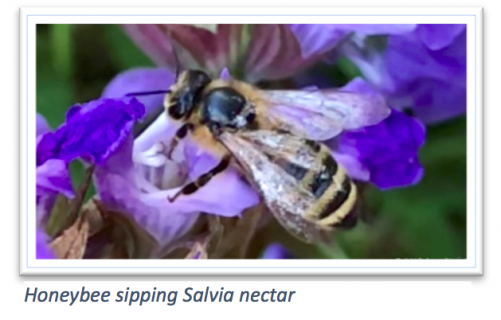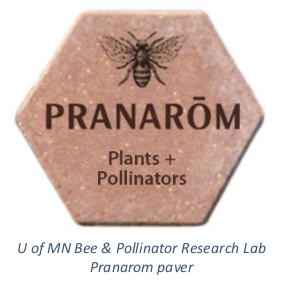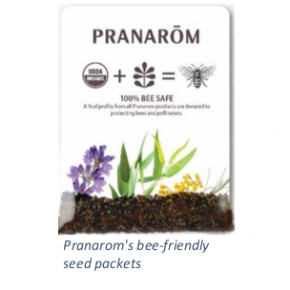by Amy Pereira BS, CHNC, RYT-200, C-MI
As the number of organic farms and organic items in the marketplace steadily rises1, more and more people are exposed to and purchasing organically grown and certified goods. For many of us, this may validate that which we’ve long believed– that choosing organic is in our collective best interest. While some organic agriculture proponents may tout details surrounding legal guidelines, marketing regulations and environmental and economic impacts, many of us are still hard-pressed to provide specific replies to questions like, “Why choose organic?” or “What makes organic preferable?”. This article aims to identify some key distinguishing points between conventional and organic farming, as well as to elevate the relationship among our earth’s plants, pollinators, and other inhabitants.
One area in which organic and conventional agriculture differ is synthetic substance use. Conventional agriculture permits the use of hundreds of synthetic pesticides, herbicides, fungicides and other chemicals which are not allowed in organic agriculture2,3. Although synthetic agricultural chemicals must be EPA-approved (and used according to specific guidelines in order to minimize potential harm to humans, livestock and other species), many are, nevertheless, believed to pose significant health risks, as seen in Dewayne Johnson v. Monsanto Company4. In addition to potential problems for humans and livestock, ubiquitous use of synthetic chemicals in farms, fields, backyards, roadsides, sidewalk cracks etc. can lead to weed resistance/superweed species and contribute to unfortunate outcomes to pollinators, like Monarch Butterfly decline5 and bee colony decline and collapse6,7,8 The presence of chemical residues, like glyphosate, in food9 also raises questions about the impact that synthetic substances may have on human gut and microbiome health. Although organic agriculture accepts a few specific synthetic substances, such as insecticidal soaps, hydrogen peroxide and pheromones, it generally bans synthetics and only accepts naturally-derived substances, like diatomaceous earth, neem and limonene, for pest and weed management3,10.
Another difference is that organic agriculture does not tolerate the use of genetically modified organisms (GMOs) to grow the food or ingredients that are used to create organic products, while conventional agriculture cooperates with biotechnology companies to use genetically modified organisms such as fast-growing AquAdvantage Salmon, non-browning Arctic apples or RoundUp Ready seeds (genetically engineered to allow crops like, corn, cotton, soy and wheat to survive RoundUp herbicide application). Producers of genetically modified organisms must fund testing to prove that a GMO is safe before the test results can be presented for governmental agency review and approval or denial of the new proposed GMO. Despite the exorbitant price and rigors of testing, one must consider the potential conflicts of interest, the source of research funding, the duration of the research, and the fact that GMO use is relatively recent in the history of agriculture—genetically-modified crops have only been used in agriculture for the past 25 years of the millennia that went before them. While GMO proponents may hope that genetic modification will help crops to withstand harsher growing conditions/climate change, to increase yields and better feed the world’s people, or to better tolerate weed sprays, critics suggest that we address underlying challenges by more significantly reducing our carbon foot print, by improving food distribution, by minimizing food waste on a local and industrial levels, and by better defending biodiversity and the species of insects and creatures that are adversely impacted by some conventional agricultural practices.
As pollinators flit from flower to flower, sipping the sweet nectar of life, they spread the pollen that allows plants to bear  seeds, fruit and the next generation of plants and to ultimately help feed the world’s inhabitants. Since pollinators, like bees, butterflies, moths, wasps, hummingbirds and bats are so instrumental in plant reproduction, they play a role not only in food production but also in essential oil, herbal supplement and virgin plant oil production. Considering the invaluable service pollinators provide, it’s only right that we draw attention to the health of these creatures– to help ensure that we may continue to reap the fruits of their labor that are so vital to the survival and wellbeing of so many species. Having conversations with local farmers or vendors at farmers markets is a great way to learn more about our food system and their practices and to keep going. Donating to charities that support healthy food systems, healthy pollinators, and environmental science is another great way to give. If you have limited disposable income, then simply choosing certified organic when possible and choosing companies that pay it forward are additional ways to vote with your dollar for changes you want to see in the world and to give back. And if you generally opt for herbal remedies, scientific aromatherapy or other complementary or alternative items over chemically synthesized medications then remember that pollinators are the bee’s knees and vital to the herbs, plants, trees, and animals that may be used to make your health, body care and wellness products, as well as to our collective overall well being!
seeds, fruit and the next generation of plants and to ultimately help feed the world’s inhabitants. Since pollinators, like bees, butterflies, moths, wasps, hummingbirds and bats are so instrumental in plant reproduction, they play a role not only in food production but also in essential oil, herbal supplement and virgin plant oil production. Considering the invaluable service pollinators provide, it’s only right that we draw attention to the health of these creatures– to help ensure that we may continue to reap the fruits of their labor that are so vital to the survival and wellbeing of so many species. Having conversations with local farmers or vendors at farmers markets is a great way to learn more about our food system and their practices and to keep going. Donating to charities that support healthy food systems, healthy pollinators, and environmental science is another great way to give. If you have limited disposable income, then simply choosing certified organic when possible and choosing companies that pay it forward are additional ways to vote with your dollar for changes you want to see in the world and to give back. And if you generally opt for herbal remedies, scientific aromatherapy or other complementary or alternative items over chemically synthesized medications then remember that pollinators are the bee’s knees and vital to the herbs, plants, trees, and animals that may be used to make your health, body care and wellness products, as well as to our collective overall well being!
Key takeaways to reduce toxic burden and support wellness of people, pollinators & planet:
- Keep it clean. Reduce potential chemical exposure and overall toxic burden to the body!
- Spread the word. Knowledge is a powerful thing so help share why organic matters to you.
- We’re all connected! Remember that choices influence self as well as the collective us.
- Vote with choices and dollars well-spent. Many organic items cost little or no more than conventional counterparts but, if you’re on a tight budget, consider produce pesticide guides such as the Environmental Working Group’s Dirty Dozen and Clean Fifteen11 which may help you to choose accordingly, as best you can!
- Give back. Not all can regularly allocate income to charitable donations but choosing organic companies that dedicate portions of their proceeds to good causes can be a great way to “donate” and a win-win for all! **
** Pranarom is the nation’s #1 selling all organic essential oil line. In honor of the symbiosis between plants and pollinators and its benefit to us all, and in efforts to educate on ways to promote pollinator health, Pranarom is committed to donating a portion of the sales of their organic Lavender essential oils (Lavandula officinalis, Lavandula officinalis reserve and Lavandula spicata) to the University of MN’s Bee Lab and Pollinator Discovery Center as well as to the non-profit Pollinator Partnership. Be also on the lookout for Pranarom’s bee–friendly seed packets and start a pollinator patch or garden near you!
For more information on the organizations above, see links below.
http://www.arboretum.umn.edu/BeeAndPollinatorCenter.aspx



References
- Bialik, K. & Walker, K. (2019, January 10). Organic farming is on the rise in the U.S. Retrieved February 19, 2019, from http://www.pewresearch.org/fact-tank/2019/01/10/organic-farming-is-on-the-rise-in-the-u-s/
- USDA Agricultural Research Service. (2016, November 2). Pesticide List. Retrieved February 19, 2019, from https://www.ars.usda.gov/northeast-area/beltsville-md-barc/beltsville-agricultural-research-center/adaptive-cropping-systems-laboratory/docs/ppd/pesticide-list/
- Electronic Code of Federal Regulations. (2019, January 22). National Organic Program list of Allowed and Prohibited Substances. Retrieved February 19, 2019, from https://www.ecfr.gov/cgi-bin/text-idx?c=ecfr&SID=9874504b6f1025eb0e6b67cadf9d3b40&rgn=div6&view=text&node=7:3.1.1.9.32.7&idno=7#se7.3.205_1601
- Levin, S. & Greenfield, P. (2018, August 11). Monsanto ordered to pay $289m as jury rules weedkiller caused man’s cancer. Retrieved February 19, 2019, from https://www.theguardian.com/business/2018/aug/10/monsanto-trial-cancer-dewayne-johnson-ruling
- Pleasants J.M. & Oberhauser K.S. (2013). Milkweed loss in agricultural fields because of herbicide use: Effect on the monarch butterfly population. Insect Conservation and Diversity. 6 (2): 135–144. Retrieved February 19, 2019 from https://onlinelibrary.wiley.com/doi/abs/10.1111/j.1752-4598.2012.00196.x
- USDA Agricultural Research Service. (2010, June). Colony Collapse Disorder Progress Report. Retrieved February 19, 2019, from https://www.ars.usda.gov/is/br/ccd/ccdprogressreport2010.pdf
- University of Minnesota. (2014, November 17). MN Impact: Discovering and Sharing the Causes of Bee Colony Collapse. Retrieved February 19, 2019, from https://www.maes.umn.edu/colony-collapse
- Neonicotinoids: Risks to bees confirmed. (2018, February 28). Retrieved February 19, 2019, from https://www.efsa.europa.eu/en/press/news/180228
- Environmental Working Group. (2018, August 15). Breakfast with a Dose of Roundup? Retrieved February 19, 2019, from https://www.ewg.org/childrenshealth/glyphosateincereal/#.W38UG_ZFyuW
- Baker, B. (2014). Can I Use this Pesticide on My Organic Farm? Retrieved February 19, 2019, from https://tilth.org/app/uploads/2014/12/can-i-use-this-pesticide.pdf
- Environmental Working Group. (2018). EWG’s 2018 Shopper’s Guide to Pesticides in Produce™. Retrieved February 19, 2019, from https://www.ewg.org/foodnews/

